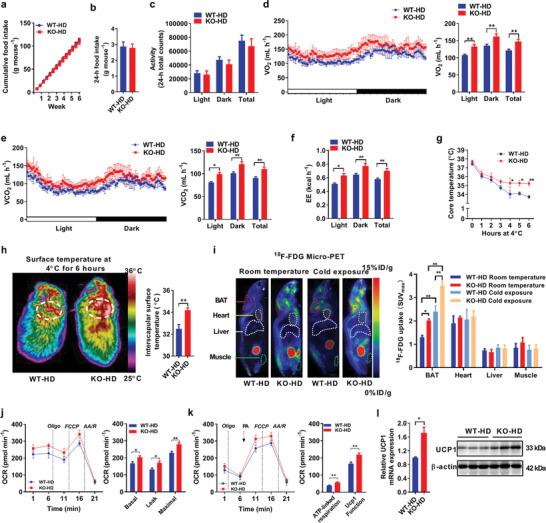Figure 3.

AKAP1 deficiency enhances energy expenditure and BAT activity in mice fed with a HFD. a) Cumulative food intake of WT and AKAP1−/− HFD mice was measured every 3 days from 15 to 21 weeks of age (n = 8–9 mice per group). b) 24 h food intake and c) physical activity of WT and AKAP1−/− HFD mice (n = 6 mice per group). d,e) Oxygen consumption (VO2) and carbon dioxide expiration (VCO2) were determined by metabolic cages in WT and AKAP1−/− HFD mice (n = 6 mice per group). f) Energy expenditure (EE) was estimated by the amount of O2 consumption and CO2 production in WT and AKAP1−/− HFD mice (n = 6 mice per group). g) Rectal core temperature of WT and AKAP1−/− HFD mice exposed to 4 °C for 6 h (n = 6 mice per group). h) Representative infrared thermography of WT and AKAP1−/− HFD mice exposed to 4 °C for 6 h (left). Surface temperature was quantified in the interscapular BAT area indicated by circle (right). n = 6 mice per group. i) Representative 18F‐FDG micro‐PET/CT images in WT and AKAP1−/− HFD mice at room temperature or cold exposure. A higher intensity of red color indicates a higher 18F‐FDG uptake. ID, injection dose (left). The areas of interscapular BAT, heart, liver, and muscle were marked and maximum standard uptake value (SUVmax) was quantified (right). n = 6 mice per group. j) Oxygen consumption rate (OCR) of BAT mitochondria was monitored by Seahorse analyzer in WT and AKAP1−/− HFD mice (n = 5 mice per group). Mitochondria (5 µg) were incubated in buffer with the following compounds: 1 µM Oligomycin (Oligo), 1 µM carbonyl cyanide 4‐(trifluoromethoxy) phenylhydrazone (FCCP, F), and 2 µM each of rotenone (R) and antimycin A (AA). Basal OCR corresponds to baseline OCR minus AA/R‐insensitive OCR; leak OCR corresponds to Oligo‐insensitive OCR minus AA/R‐insensitive OCR; maximal OCR corresponds to FCCP‐induced OCR minus AA/R‐insensitive OCR. k) UCP1 function in BAT mitochondria of WT and AKAP1−/− HFD mice (n = 5 mice per group) was monitored by Seahorse analyzer. Respiration was measured with 1 mM GDP, 10 mM pyruvate, and 5 mM malate as substrates. Mitochondria (5 µg) were incubated in buffer with the following compounds: 1 µM Oligo, 1 µM FCCP (F), 200 µM palmitate, and 4 µM each of rotenone (R) and antimycin A (AA), respectively (n = 4 per group). ATP‐linked respiration corresponds to baseline OCR minus Oligo‐insensitive OCR; Uncoupling protein 1(UCP1) function corresponds to palmitate addition phase OCR minus Oligo‐insensitive OCR. l) qRT‐PCR and Western blotting analysis for UCP1 mRNA and protein expression in BAT from WT and AKAP1−/− HFD mice (n = 3 mice per group). Data were expressed as mean ± SEM. Student's t‐test was used for analysis of the data in (b), (c), (h), (j–l). One‐way ANOVA with Bonferroni's post hoc test was used for analysis of the data in (i). Two‐way ANOVA with Bonferroni's post hoc test was used in (a) and (g). The data in (d–f) were analyzed by analysis of covariance (ANCOVA) using body weight as the covariate. *p < 0.05, **p < 0.01.
